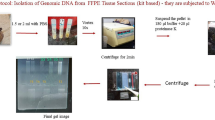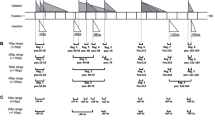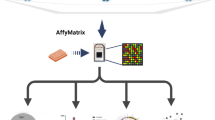Abstract
Cervical cancer is a complex polygenic disease, and the interaction between single-nucleotide polymorphisms (SNPs) may lead to differences in the incidence and susceptibility of cervical cancer. In this study, we explored whether three potentially functional SNPs—rs59661306, rs257847, and rs637442 with reference/alternative alleles A/G, C/T, and T/G, respectively—in chr5q14 were related to cervical cancer risk in a Chinese population. A total of 703 samples were collected, including 215 patients with cervical cancer and 488 normal controls. The SNP genotyping was determined by using polymerase chain reaction–restriction fragment length polymorphism. There was an association between the AG rs59661306 genotype or the GG rs59661306 genotype and cervical cancer risk, and the percentage of cancer patients with the A/G rs59661306 genotype plus the percentage of cancer patients with the G/G rs59661306 genotype (AG + GG) was significantly higher than the percentage of AG + GG healthy women in the control group. There was no association between either the rs257847 or the rs637442 and cervical cancer risk. Genotype analysis showed that the genotype CT of rs257847 in combination with the AG, GG, and AG + GG genotypes of rs59661306 were associated with a higher cervical cancer risk, and that the genotypes TG and TG + GG of rs637442 in combination with the AG and AG + GG genotypes of rs59661306 were also associated with a higher cervical cancer risk. These findings indicate that rs59661306, rs257847, and rs637442 may be susceptible loci for cervical cancer. Our study advances the understanding of SNPs that are responsible for cervical cancer susceptibility.

Similar content being viewed by others
Data Availability
All data generated or analyzed during this study are included in this published article. All authors confirm that all data and materials application support their published claims and comply with field standards.
Code Availability
Not applicable.
References
Cao H, Yang S, Yu X, Xi M. Correlation between heparanase gene polymorphism and susceptibility to endometrial cancer. Mol Genet Genomic Med. 2020;8: e1257. https://doi.org/10.1002/mgg3.1257.
Small W Jr, Bacon MA, Bajaj A, Chuang LT, Fisher BJ, Harkenrider MM, et al. Cervical cancer: a global health crisis. Cancer. 2017;123:2404–12. https://doi.org/10.1002/cncr.30667.
Arbyn M, Castellsague X, de Sanjose S, Bruni L, de Saraiya M, Bray F, et al. Worldwide burden of cervical cancer in 2008. Ann Oncol. 2011;22:2675–86. https://doi.org/10.1093/annonc/mdr015.
Vinothkumar V, Arun K, Arunkumar G, Revathidevi S, Ramani R, Bhaskar L, et al. Association between functional TERT promoter polymorphism rs2853669 and cervical cancer risk in South Indian women. Mol Clin Oncol. 2020;12:485–94. https://doi.org/10.3892/mco.2020.2003.
Chen D, Juko-Pecirep I, Hammer J, Ivansson E, Enroth S, Gustavsson L, et al. Genome-wide association study of susceptibility loci for cervical cancer. J Natl Cancer Inst. 2013;105:624–33. https://doi.org/10.1093/jnci/djt051.
Golubickaite I, Ugenskiene R, Cepaite J, Ziliene E, Inciura A, Poskiene L, et al. Mitochondria-related TFAM gene variants and their effects on patients with cervical cancer. Biomed Rep. 2021;15:106. https://doi.org/10.3892/br.2021.1482.
Ramachandran D, Dörk T. Genomic risk factors for cervical cancer. Cancers (Basel). 2021;13:5137. https://doi.org/10.3390/cancers13205137.
Chen D, Gyllensten U. Lessons and implications from association studies and post-GWAS analyses of cervical cancer. Trends Genet. 2015;31:41–54. https://doi.org/10.1016/j.tig.2014.10.005.
Takeuchi F, Kukimoto I, Li Z, Li S, Li N, Hu Z, et al. Genome-wide association study of cervical cancer suggests a role for ARRDC3 gene in human papillomavirus infection. Hum Mol Genet. 2019;28:341–8. https://doi.org/10.1093/hmg/ddy390/5168482.
Flodby P, Liao D, Blanck A, Xanthopoulos K, Hallstrom I. Expression of the liver-enriched transcription factorsC/EBP alpha, C/EBP beta, HNF-1, and HNF-4 in preneoplastic nodules and hepatocellular carcinoma in rat liver. Mol Carcinog. 1995;12:103–9. https://doi.org/10.1002/mc.2940120207.
Duggal P, Gillanders E, Holmes T, Bailey-Wilson J. Establishing an adjusted p-value threshold to control the family-wide type 1 error in genome wide association studies. BMC Genomics. 2008;9:516. https://doi.org/10.1186/1471-2164-9-516.
Arakaki A, Pan W, Wedegaertner H, Roca-Mercado I, Chinn L, Gujral T, et al. α-Arrestin ARRDC3 tumor suppressor function is linked to GPCR-induced TAZ activation and breast cancer metastasis. J Cell Sci. 2021;15(134):jcs254888. https://doi.org/10.1242/jcs.254888.
Badve S, Dabbs D, Schnitt S, Baehner F, Decker T, Eusebi V, et al. Basal-like and triple-negative breast cancers: a critical review with an emphasis on the implications for pathologists and oncologists. Mod Pathol. 2011;24:157–67. https://doi.org/10.1038/modpathol.2010.200.
Subhawong A, Subhawong T, Nassar H, Kouprina N, Begum S, Vang R, et al. Most basal-like breast carcinomas demonstrate the same Rb-/p16+ immunophenotype as the HPV-related poorly differentiated squamous cell carcinomas which they resemble morphologically. Am J Surg Pathol. 2009;33:163–75. https://doi.org/10.1097/PAS.0b013e31817f9790.
Lin Y, Zhao J, Hu X, Wang L, Liang L, Chen W. Transcription factor CCAAT/enhancer binding protein alpha up-regulates microRNA let-7a-1 in lung cancer cells by direct binding. Cancer Cell Int. 2016;16:17. https://doi.org/10.1186/s12935-016-0294-5.
Kruppel U, Muller-Schiffmann A, Baldus S, Smola-Hess S, Steger G. E2 and the co-activator p300 can cooperate in activation of the human papillomavirus type 16 early promoter. Virology. 2008;377:151–9. https://doi.org/10.1016/j.virol.2008.04.006.
Pan Z, Zheng W, Zhang J, Gao R, Li D, Guo X, et al. Down-regulation of the expression of CCAAT enhancer binding protein α gene in cervical squamous cell carcinoma. BMC Cancer. 2014;14:417. https://doi.org/10.1186/1471-2407-14-417.
Liu Y, Kanyomse Q, Xie Y. Tumor-suppressive activity of Hnf1beta in Wilms’ tumor. Biosci Biotechnol Biochem. 2019;83:2008–15. https://doi.org/10.1080/09168451.2019.1611409.
Bartu M, Hojny J, Hajkova N, Michalkova R, Krkavcova E, Simon K, et al. Expression, epigenetic, and genetic changes of HNF1B in colorectal lesions: an analysis of 145 cases. Pathol Oncol Res. 2020;26:2337–50. https://doi.org/10.1007/s12253-020-00830-2.
Li S, Li G, Kong F, Liu Z, Li N, Li Y, et al. The Association of CYP1A1 gene with cervical cancer and additional SNP-SNP interaction in Chinese Women. J Clin Lab Anal. 2016;30:1220–5. https://doi.org/10.1002/jcla.22006.
Mao J, Wu L, Wang W, Ye Y, Yang J, Chen H. Nucleotide variation in ATG4A and susceptibility to cervical cancer in Southwestern Chinese women. Oncol Lett. 2018;15:2992–3000. https://doi.org/10.3892/ol.2017.7663.
Acknowledgements
This study was funded by grants from the Key Research and Development Projects of Sichuan Science and Technology Department (2019YJ0044). We thank all participants for this study.
Funding
This work was supported by grants from the Key Research and Development Projects of Sichuan Science and Technology Department (2019YJ0044).
Author information
Authors and Affiliations
Contributions
All authors contributed to the study conception and design. Literature search, experimental studies, data analysis, statistical analysis, manuscript preparation, and manuscript editing were performed by Yuqing Liu and Ling Mei. Data acquisition, manuscript editing, and manuscript review were performed by Yueyue Chen, Xiaoli Zhang, Dongmei Wei, Tao Cui, Yueting Zhang, Tao Wang, and Xiaoyu Niu. Xiaoyu Niu takes responsibility for the integrity of the work as a whole from inception to published article. All authors commented on previous versions of the manuscript. All authors read and approved the final manuscript.
Corresponding authors
Ethics declarations
Ethics Approval
This study was performed in line with the principles of the Declaration of Helsinki. The study was approved by the institutional ethics committee of West China Second Hospital of Sichuan University.
Consent to Participate
Informed consent was obtained from all individual participants included in the study.
Consent for Publication
Consent for publication was obtained from all individual participants included in the study.
Competing Interests
The authors declare no competing interests.
Additional information
Yuqing Liu and Ling Mei have contributed equally to this work and share first authorship.
Tao Wang and Xiaoyu Niu have contributed equally to this work and share first authorship.
Rights and permissions
About this article
Cite this article
Liu, Y., Mei, L., Chen, Y. et al. Association Between Potentially Functional Variants in chr5q14 and the Risk of Cervical Cancer in a Chinese Population. Reprod. Sci. 30, 301–308 (2023). https://doi.org/10.1007/s43032-022-01032-8
Received:
Accepted:
Published:
Issue Date:
DOI: https://doi.org/10.1007/s43032-022-01032-8




